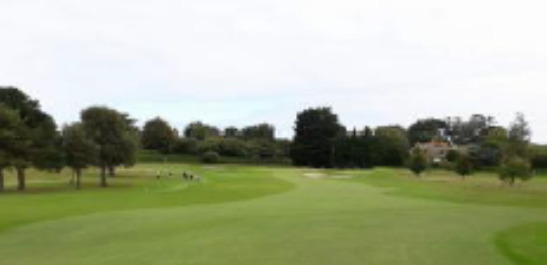The Sports Turf Research Institute (STRI) is the world’s leading authority on the maintenance of golf courses (https://strigroup.com) One of their key clients is the R&A, advising them on the presentation of the courses used for the Open Championship. They have been providing advice to Greystones Golf Club since 2012 on the maintenance of the golf course. Included in their service is an annual visit where objective data is gathered and an advisory report produced. Their most recent visit to the club was on 2nd September 2021.
Over the past 3 years the STRI have been assisting us to face the challenge presented by the banning of many of the fungicides and pesticides traditionally used by golf clubs to control disease and the damage caused by worms and leatherjackets. The key recommendation has been to attempt to seed finer grass, in particular bentgrass, on our greens. This grass type is far more resistant to disease than the dominant meadow grass native to our greens.
The highlight of the most recent report is in the first paragraph:
“The performance of the greens presented on the day was reflected in the best set of data collected this year in my travels which is being achieved without ironing and with a slightly more relaxed mowing height. They were within Open Championship standard in terms of ball roll quality Managing the greens as you do to balance bentgrass promotion and playability is best practice.”
Other highlights included:
“It was hard to fault the quality of the tees in terms of grass cover, appearance and stability underfoot.”
“The definition and quality of the fairways from the tee was of the highest order.”
Below are some photographs and comments on the course:
Figure 1: Good increase in creeping bentgrass to the 4th green away from the front. The medium green coloured bentgrasses are the desired types rather than the native grey tones. There was more noticeable increase, albeit mainly to less trafficked parts, to the front nine. It is reported that there is more casual golf played on the back nine. A very good bentgrass seed strike was seen on the day. How much persists will be down to the traffic levels and height of cut.
Figure 9: High quality definition on the 18th. The mowing regime is responsive to growth fluctuations and well on top of it. The quality of cut was impressive to it and all short mown elements.
Figure 6: The 17th tee like all was coping very well with wear due to the stability under foot (due to sand inputs), good nitrogen and water inputs. It is an achievement to deliver such condition given the extremely high volume of traffic.
Figure 8: Great work seen to lighten the right side of the 12th hole.
Council wishes to thank Keith Clancy and his team of Eoin, Dave, Keith, Peter, Shane and Liam on their excellent work.
Keith has written a piece on the factors governing green speed below:
Factors that influence green speed.
As we have communicated before, we are taking measures to promote bent grass in our greens and reduce the amount of meadow grass.
We have also mentioned the fact that the days of producing very fast greens all season long are a thing of the past as it is no longer sustainable due to changes in legislation and also environmental factors. Particularly as we go through the transition stage.
In order to produce an environment that encourages bent and reduces meadow grass we must disrupt the surface as little as possible, raise height of cuts as much as possible, reduce thatch, increase topdressing, reduce fertility and maintain optimum moisture levels.
The main factor that contributes to the speed of a green is the friction with the ball. That can be a combination of friction with the grass leaf, moisture or sand particles.
With the higher height of cut there is understandably more grass on the greens so the ball will run more slowly, however there are a number of factors that will influence the amount of grass and the quality of the grass tip that will influence green speed.
In an ideal world greens would be cut with very sharp mowers and only when the grass leaf is dry and there is no sand on the green.
The mowers work with a similar action to a scissors. As with a scissors if it tries to cut something that is wet not all of it will be cut leaving some parts longer than others. It will not cut cleanly and leave a somewhat serrated finish. The same is true with the mowers. It is thought that the difference in speed between a dry and a wet cut is approximately 1 foot. It’s very difficult for us to cut greens when they are dry as golf starts so early in the morning. There is almost always a dew on the greens. The dew has been particularly bad over the past 2 months as there has been very little wind during the night which helps to stop it forming
When we feed the greens there is usually a flush of growth. This means that the mowers are trying to cut more grass leaves at any given time. As with a scissors it’s more difficult to cut 10 pieces of paper than 4. The solution to this is usually to double cut the greens. This however has an impact on the bent grass as we are trying to reduce the amount of wear on the greens surface.
We also have to continue topdressing the greens which takes the edge off the blades very quickly. Ideally the greens would be top-dressed in the mornings and left to dry out. Then the sand would be brushed in (when dry). However, because golfers don’t want to play on sandy greens we have to do our best to get as much sand into the surface while it’s still wet before golf starts . This means that there is always some sand on the surface the following morning when the greens are being cut. This also impacts on green speed as mowers are not getting a clean cut on the grass leaf therefore more friction.
I think most golfers understand that when a green is wet it’s slower. It doesn’t have to be visible to the eye though. Even the slightest bit of moisture on the grass leaf will impact on green speed. This is very much out of our control.
We are working with a number of variables that will impact green speed and during the season we do our best to maintain a consistent speed, but when working with nature there are always going to be things that are out of our control and speeds will fluctuate. This has always been the case but perhaps not so obvious when the greens were running very fast at 10 or 11 feet. If there was a reduction of 6 to 8 inches the greens were still very fast.
Now, when the greens are running between 8.5 and 9.5 the small reduction in speed is a lot more obvious. However, as the STRI report attests, we are still producing good data in terms of smoothness and trueness despite the higher height of cut necessary to promote the finer grass.





